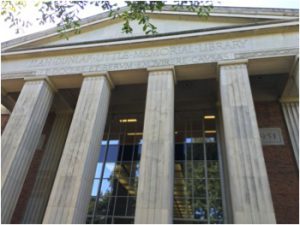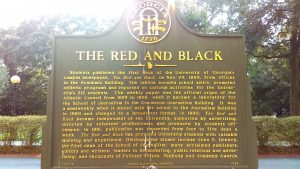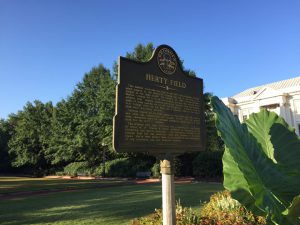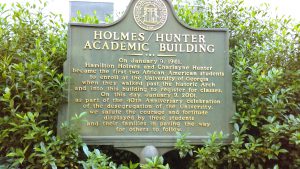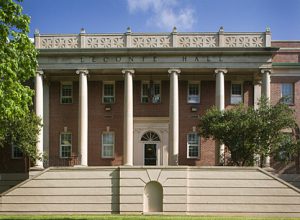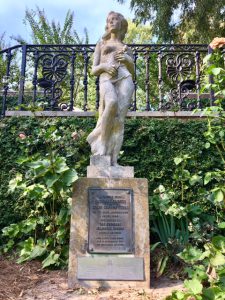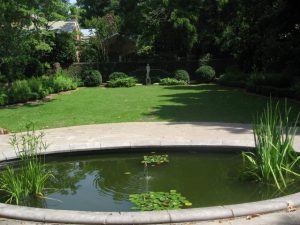Ilah Dunlap-Little (1873 – 1939) of Macon Georgia, willed nearly half a million dollars to the University of Georgia for “the cherished idea” of her and her husband, John D. Little – a new library. It is a memorial to her father, Samuel Scott Dunlap; her mother, Mary S. Dunlap; her brother, Samuel Scott Dunlap, Jr.; and her husbands, Leonidas A. Jordan and John D. Little. Mrs. Dunlap directed that it be built with red brick, surrounded by columns, and sit on the site occupied by the Chancellor House. She also directed family portraits and certain furnishings be placed in the library. However, with a special court order, Mrs. Dunlap’s belongings were placed in the Lustrat House, which was renamed the Ilah Dunlap- Memorial Library Annex, because the trustees deemed the library too contemporary. The Ilah Dunlap Memorial Library was dedicated on November 19, 1953 and holds a 700,000 volumes.
Red & Black Newspaper Marker
The Red & Black Newspaper was founded in 1893 as a means to connect students with their campus and to also be the training ground for aspiring journalists and news media specialists. It is the largest circulating college newspaper in Georgia, and covers a diverse spectrum of content: UGA and Athens news, sports, fine arts, opinion pieces and cultural activities. For 87 years, the Red & Black was the official tabloid of UGA athletics and cultural events; however, in 1980, the State Board of Regents proclaimed the newspaper to be independent from UGA, therefore ending the official connection and all university- based funding. To continue publication, the paper is supported by local advertisements and from a volunteer board of directors. Currently, the Red & Black publishes 10,000 print copies weekly, both on and off campus. Since 2010, it has operated digitally providing its readership 24/7 access to all stories and bulletins. For demonstrating excellence in journalism, the newspaper has been awarded the National Peacemaker Award on numerous occasions .
Sources:
http://dlg.galileo.usg.edu/cgi-bin/ebind2html.pl/reed_c09?seq=151
http://www.redandblack.com/site/about_the_red__black.html
Herty Field
Herty Field was the site of the University Georgia’s sports events most notably baseball and football. The first intercollegiate football game in the South was played here again Mercer University. It was a win for Georgia and began the University’s long tradition of excellence in the sport. After going through a couple of different incarnations as a practice field and then a parking lot, the field was commemorated to the founder of the football team and chemistry professor, Dr. Charles Herty. Herty’s accomplishments aside from the elevation of sports for the institution include the establishment of the papermaking industry in the South, saving the longleaf pine from extinction in the region, playing a founding role in the National Institute of Health, and serving as President of the American Chemical Society.
Sarah Hall Bradley

Sarah Hall Bradley was a prominent southerner whose legacy lives on through her charitable foundation, the W. C. and Sarah Hall Bradley Foundation. She was born around the late 1860s, married W. C. Bradley in 1887, and died in 1936. Her father was a wealthy Connecticut financer of shipbuilding, but she grew up in Columbus, Georgia. Her husband, son of a slaveholder in Columbus, Georgia, was a wealthy businessman who owned a cotton firm, and bought Coca-Cola with a group of investors in 1919. Sarah had two children, Forbes and Elizabeth. Forbes died a few months after he was born, but Elizabeth grew up to marry D. Abbott Turner. The two couples joined their charitable foundations into the Bradley Turner Foundation, which continues to give grants to universities throughout Georgia, including the University of Georgia. Sarah was a daughter of the American Revolution and a well-loved citizen of Columbus, Georgia for most of her life.
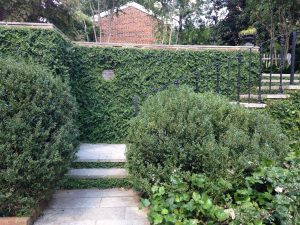 Sarah was one of 20 founding members of the Charter Garden Club of Columbus, Georgia. As noted in the club’s 1939 scrapbook, “the Club was deeply sadened [sic] by the loss of one of its most beloved members when Mrs. W. C. Bradley passed away on December 30, 1936.” The Ladies Garden Club of Athens, instigators of the Founders Memorial Garden at UGA, sponsored the admission of the Charter Garden Club into Georgia’s Garden Club organization in 1929. The clubs under this umbrella helped raise funds for the Founders Memorial Garden, and also contributed several monuments to the garden. The Charter Garden Club erected steps in the Founders Memorial Garden at UGA in memory of Sarah Hall Bradley circa 1940, around the time of the garden’s opening. The steps connect a sunken perennial garden to the courtyard behind the Founders House. Both Sarah and her daughter Elizabeth are remembered in gardens in Athens; Elizabeth is memorialized by the Elizabeth Bradley Turner Rose Garden at the State Botanical Gardens.
Sarah was one of 20 founding members of the Charter Garden Club of Columbus, Georgia. As noted in the club’s 1939 scrapbook, “the Club was deeply sadened [sic] by the loss of one of its most beloved members when Mrs. W. C. Bradley passed away on December 30, 1936.” The Ladies Garden Club of Athens, instigators of the Founders Memorial Garden at UGA, sponsored the admission of the Charter Garden Club into Georgia’s Garden Club organization in 1929. The clubs under this umbrella helped raise funds for the Founders Memorial Garden, and also contributed several monuments to the garden. The Charter Garden Club erected steps in the Founders Memorial Garden at UGA in memory of Sarah Hall Bradley circa 1940, around the time of the garden’s opening. The steps connect a sunken perennial garden to the courtyard behind the Founders House. Both Sarah and her daughter Elizabeth are remembered in gardens in Athens; Elizabeth is memorialized by the Elizabeth Bradley Turner Rose Garden at the State Botanical Gardens.
Sources:
“Charter Garden Club Scrapbook, 1937-1938.” Columbus, GA, 1938. Garden Club of Georgia records, box 46. Hargrett Rare Book and Manuscript Library, Athens, GA.
“Charter Garden Club Scrapbook, 1938-1939.” Columbus, GA, 1939. Garden Club of Georgia records, box 47. Hargrett Rare Book and Manuscript Library, Athens, GA.
“D. Abbott Turner (1892-1982).” New Georgia Encyclopedia. Accessed September 30, 2016. http://www.georgiaencyclopedia.org/articles/business-economy/d-abbott-turner-1892-1982.
Daughters of the American Revolution. Lineage Book – National Society of the Daughters of the American Revolution. Vol. XXIX. Daughters of the American Revolution, 1899.
“Founders Memorial Garden – College of Environment + Design.” Accessed September 26, 2016. http://www.ced.uga.edu/about/facilities/founders-memorial/.
Kennedy, Linda J., and Mary Jane Galer. Historic Linwood Cemetery. Charleston, SC: Arcadia Publishing, 2004.
“Sarah Hall Bradley ( – 1936) – Find A Grave Memorial.” Accessed September 30, 2016. http://www.findagrave.com/cgi-bin/fg.cgi?page=gr&GRid=22397791.
“W. C. Bradley (1863-1947).” New Georgia Encyclopedia. Accessed September 30, 2016. http://www.georgiaencyclopedia.org/articles/business-economy/w-c-bradley-1863-1947.
Bernard Ramsey Statue
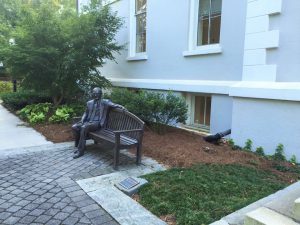
Bernard B. Ramsey (1915-1996) graduated from the University of Georgia’s Terry College in the class of 1937. After serving in United States Army Air Forces during World War Two, he had a successful sales career with Merrill Lynch & Company Inc. During this time, he served as a trustee to the University. After his retirement from Merrill Lynch, he became the largest single donor to the University ever in 1993 when he established a trust that went “toward scholarships, new buildings, and an endowment for a research chair.” After he passed away in 1996 an even larger sum was willed to the University. This sculpture was created by Teena Stern and Don Haugen on October 1, 2004 and is near Moore College.
Holmes/ Hunter Marker
Demosthenian Hall
Founded in 1803, the Demosthenian Literary Society is a student run organization that focuses on the value of debate and intellectual discussion. Forced to meet in classrooms during their initial years, students and alumni raised money to fund the construction of Demosthenian Hall in 1824, giving the society a permanent home on campus. Describing this new addition to campus, the Athenian describes the hall as a “handsome Brick Building, with a beautiful hall…in a flourishing condition”(April 18, 1828). Advertising anniversary celebrations and debates in the local paper, the Demosthenian Society appears to have been very active in the college community, frequently engaging in debate with the Phi Kappa Society, a rival literary society on campus. In the years prior to the Civil War, however, the tone of these advertisements begins to change. Published in the Southern Watchman on July 12th, 1860, a note is addressed to the “Gentlemen of the Demosthenian and Phi Kappa Societies,” emphasizing the importance of state pride and patriotism, calling on these young men to “struggle ever for her rights” and to “shed the last drop of your blood rejoicing, to defend her honor and protect her homes,” wishing them “a happy victory or else a glorious grave.” A particularly notable member of the Demosthenian Society was Robert Toombs, who would later become a founding member of the Confederacy, serving as Secretary of State under Jefferson Davis (Reed, 296). While the society’s website includes his name among those they consider notable members, there is no real acknowledgment concerning his role as a founding member of the Confederacy.
Resources:
Demosthenian Literary Society at The University of Georgia, “The Hall,” http://www.dlsuga.com/
Athens Historic Newspaper Archive, http://athnewspapers.galileo.usg.edu/athnewspapers-j2k/search
Reed, Thomas Walter. History of The University of Georgia (unpublished typescript). 1946. http://dlg.galileo.usg.edu/reed/
LeConte Hall
Located on the corner of Jackson and Baldwin Street, LeConte Hall was dedicated to scientist Joseph LeConte in 1905, four years after his death on a camping trip in Yosemite. A graduate of and professor at the University of Georgia, LeConte was an important figure in the scientific community at the time. Known to be controversial, LeConte was an early proponent of Darwin’s evolutionary theory, teaching the subject before it had been widely accepted. As noted in Thomas Walter Reed’s History of the University of Georgia, “his views on that subject were quite antagonistic to those of President Church…and the chief executive of the Georgia institution did not approve of such instruction”(Reed, 405). After his departure form the University of Georgia in 1856, Joseph LeConte worked at the University of South Carolina for a time, then later accompanied his brother “to California to take part in the establishment of the University of California”(Reed, 404). An accomplished scientist and an early pioneer in his academic field, LeConte Hall would serve as the first home of the University of Georgia’s biology department. As described in the local the paper The Banner, LeConte Hall was “one of the most up-to-date university buildings in the country”(June 32, 1905). Though currently home to the history department, LeConte Hall still maintains a connection to its namesake through a large portrait of Joseph LeConte in main foyer of the building.
Resources:
Stephens, Lester D. “LeConte Family.” New Georgia Encyclopedia. 15 September 2014. Web. 29 September 2016.
Railsback, Bruce, “Joseph LeConte, Third Professor of Geology at the University of Georgia from 1852 to 1856,” http://www.gly.uga.edu/railsback/UGAGeolHistLeConte.html
Reed, Thomas Walter. History of The University of Georgia (unpublished typescript). 1946. http://dlg.galileo.usg.edu/reed/
Athens Historic Newspaper Archive, http://athnewspapers.galileo.usg.edu/athnewspapers-j2k/search
Founder Memorial Garden Sculpture
This statue was bestowed upon the University’s Founders Memorial Garden by the National Council of State Garden Clubs to commemorate the organization’s 25th anniversary in April of 1954. The sculpture was designed and created by Sarasota, Florida native, L.T. Posey– who was also a veteran of the United States Army. The base of the statue bears an inscription that reads, “For every good thing has a beginning and the beginning was here.” An additional plaque was lately added to the statue that reads “The Ice Follies Daffodils, Cloud Ballet Irises and Sunstruck Roses in this bed were painted by artist Annie Laurie Dodd for the Southern Garden Series watercolor print collection honoring the 75th anniversary of the Founders Memorial Garden (1939-2014) and the 125th anniversary (1891-2016) of the Ladies’ Garden Club, America’s first garden club.” This organization was founded with the overall goal being “To promote a love of gardening for the amateur and the professional; to protect our native trees, wild flowers and birds; and to encourage a regard for civic beauty in our various communities.”
Sources:
Cothran, James R. “Garden Club of Georgia.” New Georgia Encyclopedia. 09 September 2014. Web. 28 September 2016.
Johnnie Kyle Woodruff Pond
The Pond is located in the Founders Memorial Garden, and it is considered an informal area. The pond is dedicated to Johnnie Kyle Woodruff of Columbus, Georgia. Specifics on Johnnie Kyle Woodruff were difficult to locate, but the Woodruff family seems to have powerful ties to Columbus, Georgia. The Woodruff family propelled Coca Cola to international recognition during much of the twentieth century. Perhaps Johnnie Kyle Woodruff’s connection to Coca Cola is the reason the pond was erected. More information about Johnnie Kyle Woodruff’s life and death would be invaluable to understanding exactly why the pond was established. Other questions left unanswered is when exactly the pond was erected, as well as who financed the memorial to Johnnie Kyle Woodruff.
Resources
Lupold, John S. “Columbus.” New Georgia Encyclopedia. 26 August 2013. Web. 29 September 2016.
https://beta.worldcat.org/archivegrid/collection/data/433061432

